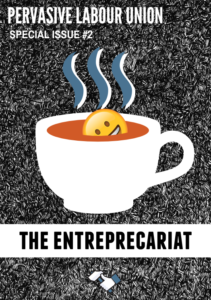This contribution by Dr. Phoebe Moore is part of the special issue of the Pervasive Labour Union zine on the Entreprecariat. Read it here and download it for free as PDF or EPUB.
An unstable matrix emerges with the rise of exploitative work contracts, digitalised management interfaces, and intensified tracking capacities which negatively impact working conditions and provide an attempted means to capture and control the totality of life and work in conditions of precarity. New technologies offer the possibility to measure emotional and affective labour, including variable moods and subjectivities, reactions to situations, tone of voice, gestures and other movements that are seen to reflect people’s emotional states and affect as well, as I argue in the book. The measurement tools for all-of-life, in workplaces come in the same packages as health and fitness as well as productivity tracking devices.
Employers and clients capture and use data for what is called ‘people analytics’, reputation profiling, electronic performance management, platform work interface management and surveillance. Given all of these areas for capture, why not capture emotional and affective labour? Wellness programmes have now begun to include information about workers’ daily steps, stairs climbed and sleep. This information will soon be used to understand our states of well-being, mental health and financial wellness. These are typical areas where unseen labour is captured in professional workplaces, which are only somewhat less impacted by precarity. Digitalisation of unseen labour is quite different from the measure of work by older forms of technologies such as seen in scientific management, where there was some attention paid to fatigue (but not joy or distress). The capture of unseen labour produces an ‘immaterial’ form of value creation [1] and it provides data that intends to reflect labour that was not considered possible for measure in the past. Measurement of productivity at work is now not limited to material outputs, but invades into subjectivities, affect and emotion [2].
The fact that management is beginning to measure unseen labour could be due to the diminishing of traditional workplaces where managers could once physically see and speak to employees, a phenomenon evident in most industries, so data accumulation could be a substitute for this lack of face to face contact. Or perhaps it is due to the awareness of sedentarism in workplaces which themselves began to occupy temporal and spatial dimensions as people began to use computers and other machines more frequently for work, perhaps impacting people’s physical health and lowering productivity. In February 2015, the ONS announced that output per hour in the UK was 17 percentage points below the average for the rest of the major G7 advanced economies in 2013, which is the widest productivity gap since 1992. The Netherlands has also experienced a slowing in productivity growth. The Labour Force Survey in 2008/9 reported that 415,000 individuals in the UK were suffering from stress, anxiety or depression that people believed had been caused and worsened by current or previous work, second only in prevalence to musculoskeletal disorders [3].
While unidirectional forms of productivity measure gathered by tracking techniques in factories and warehouses are well-known, non-industry corporations have begun to use technologies to capture data about workers in a way that not only measures productivity but is designed to increase motivation and productivity of more cognitive work. New forms of surveillance surround emerging methods of self- and other-tracking at work. Surveillance is no longer something that happens to ‘other people’. It is all around us. We are expected to watch one another and watch ourselves. New technologies are now being deployed to monitor and control work as well as to provide services. Emotions and affective labour are the new terrain of capture for management through quantification made increasingly intimate along a continuum of management scrutiny. Explicit management attempts to measure affectivity challenge perceived divisions and hierarchies between the body and the mind. In that context, affect and emotional labour become areas of corporate colonisation as seen in new workplace experiments.
[1] Maurizio Lazzarato. 1996. “Immaterial Labor”. In Radical Thought in Italy: A Potential Politics. edited by Paolo Virno and Michael Hardt, University of Minnesota Press.
[2] See Kathi Weeks. 2011. The Problem with Work: Feminism, Marxism, Antiwork Politics, and Postwork Imaginaries. Duke University Press.
[3] HSE, cited in Donaldson-Feilder and Podro, The future of health and wellbeing in the workplace [online]. Acas Policy Discussion Paper. London: Acas, p. 6.
In this contribution, Moore summarizes some of the ideas included in her book ‘The Quantified Self in Precarity: Work, Technology and What Counts’ (Routledge, 2017). The book offers both a deep theoretical and philosophical investigation of the implications that intimate forms of tracking capture value in areas of labour less explored; and contains a series of case studies including the first example of in depth research on one company’s Quantified Workplace, where Moore periodically interviewed workers who were given FitBits and used productivity software over the course of a year. The book contains a series of in depth personal interviews including one with Chris Dancy, who has been called ‘the most connected man on the planet’ for extreme self tracking his work and other activities, and a series of self trackers with extensive experience in this domain. Email Phoebe for more information pvm.doc at gmail.com
Also published on Medium.

